Pitch Control
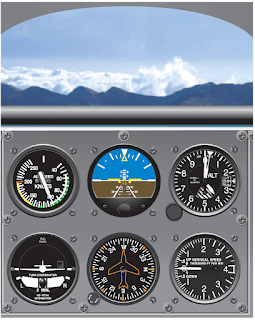 |
| Figure 1. Pitch attitude and airspeed in level flight, slow cruise speed |
 |
| Figure 2. Pitch attitude and airspeed in level flight, fast cruise speed |
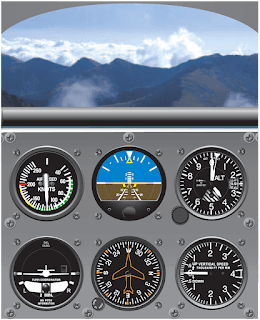 |
| Figure 3. Pitch attitude and airspeed in level flight, normal cruise speed |
Attitude Indicator
The attitude indicator gives the direct indication of pitch attitude. The desired pitch attitude is gained by using the elevator control to raise or lower the miniature aircraft in relation to the horizon bar. This corresponds to the way pitch attitude is adjusted in visual flight by raising or lowering the nose of the airplane in relation to the natural horizon. However, unless the airspeed is constant, and until the level flight attitude for that airspeed has been identified and established, there is no way to know whether level flight as indicated on the attitude indicator is resulting in level flight as shown on the altimeter, VSI, and ASI. If the miniature aircraft of the attitude indicator is properly adjusted on the ground before takeoff, it shows approximately level flight at normal cruise speed when the pilot completes the level off from a climb. If further adjustment of the miniature aircraft is necessary, the other pitch instruments must be used to maintain level flight while the adjustment is made.
To practice pitch control for level flight using only the attitude indicator, use the following exercise. Restrict the displacement of the horizon bar to a one-half bar width, a bar width up or down, then a one-and-one-half bar width. One-half, one, and one-and-one-half bar width nose-high attitudes are shown in Figures 4, 5, and 6.
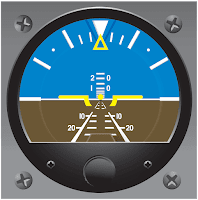 |
| Figure 4. Pitch correction for level flight, one-half bar width |
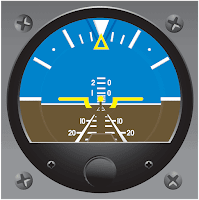 |
| Figure 5. Pitch correction for level flight, one bar width |
 |
| Figure 6. Pitch correction for level flight, one-and-one-half bar width |
An instructor pilot can demonstrate these normal pitch corrections and compare the indications on the attitude indicator with the airplane’s position to the natural horizon.
Pitch attitude changes for corrections to level flight by reference to instruments are much smaller than those commonly used for visual flight. With the airplane correctly trimmed for level flight, the elevator displacement and the control pressures necessary to effect these standard pitch changes are usually very slight. The following are a few helpful hints to help determine how much elevator control pressure is required.
First, a tight grip on the controls makes it difficult to feel control pressure changes. Relaxing and learning to control the aircraft usually takes considerable conscious effort during the early stages of instrument training.
Second, make smooth and small pitch changes with positive pressure. With practice, a pilot can make these small pitch corrections up or down, “freezing” (holding constant) the one-half, full, and one-and-one-half bar widths on the attitude indicator.
Third, with the airplane properly trimmed for level flight, momentarily release all pressure on the elevator control when becoming aware of tenseness. This is a reminder that the airplane is stable; except under turbulent conditions, it maintains level flight if left alone. Even when no control change is called for, it is difficult to resist the impulse to move the controls. This may be one of the most difficult initial training problems in instrument flight.
Altimeter
At constant power, any deviation from level flight (except in turbulent air) is the result of a pitch change. Therefore, the altimeter gives an indirect indication of the pitch attitude in level flight, assuming constant power. Since the altitude should remain constant when the airplane is in level flight, any deviation from the desired altitude signals the need for a pitch change. If the aircraft is gaining altitude, the nose must be lowered. [Figures 7 and 8]
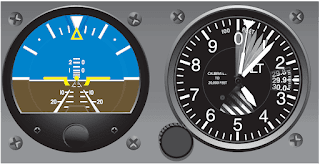 |
| Figure 7. Using the altimeter for pitch interpretation, a high altitude means a nose-high pitch attitude |
 |
| Figure 8. Pitch correction following altitude increase—lower nose to correct altitude error |
The rate of movement of the altimeter needle is as important as its direction of movement in maintaining level flight without the use of the attitude indicator. An excessive pitch deviation from level flight results in a relatively rapid change of altitude; a slight pitch deviation causes a slow change. Thus, if the altimeter needle moves rapidly clockwise, assume a considerable nose-high deviation from level flight attitude. Conversely, if the needle moves slowly counterclockwise to indicate a slightly nose-low attitude, assume that the pitch correction necessary to regain the desired altitude is small. As the altimeter is added to the attitude indicator in a crosscheck, a pilot learns to recognize the rate of movement of the altimeter needle for a given pitch change as shown on the attitude indicator.
To practice precision control of pitch in an airplane without an attitude indicator, make small pitch changes by visual reference to the natural horizon and note the rate of movement of the altimeter. Note what amount of pitch change gives the slowest steady rate of change on the altimeter. Then practice small pitch corrections by accurately interpreting and controlling the rate of needle movement.
An instructor pilot can demonstrate an excessive nose-down deviation (indicated by rapid movement of the altimeter needle) and then, as an example, show the result of improper corrective technique. The normal impulse is to make a large pitch correction in a hurry, but this inevitably leads to overcontrolling. The needle slows down, then reverses direction, and finally indicates an excessive nose-high deviation. The result is tension on the controls, erratic control response, and increasingly extreme control movements. The correct technique, which is slower and smoother, returns the airplane to the desired attitude more quickly, with positive control and no confusion.
As a rule of thumb, for errors of less than 100 feet, use a half bar width correction. [Figures 9 and 10] For errors in excess of 100 feet, use an initial full bar width correction. [Figures 11 and 12] Practice predetermined altitude changes using the altimeter alone, then in combination with the attitude indicator.
 |
| Figure 9. Altitude error, less than 100 feet |
 |
| Figure 10. Pitch correction, less than 100 feet—one-half bar low to correct altitude error |
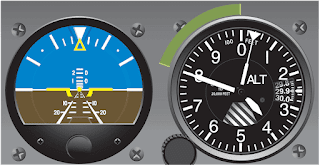 |
| Figure 11. Altitude error, greater than 100 feet |
 |
| Figure 12. Pitch correction, greater than 100 feet—one bar correction initially |
Vertical Speed Indicator (VSI)
The VSI, like the altimeter, gives an indirect indication of pitch attitude and is both a trend and a rate instrument. As a trend instrument, it shows immediately the initial vertical movement of the airplane, which disregarding turbulence can be considered a reflection of pitch change. To maintain level flight, use the VSI in conjunction with the altimeter and attitude indicator. Note any positive or negative trend of the needle from zero and apply a very light corrective elevator pressure. As the needle returns to zero, relax the corrective pressure. If control pressures have been smooth and light, the needle reacts immediately and slowly, and the altimeter shows little or no change of altitude. As a rate instrument, the VSI requires consideration of lag characteristics.
Lag refers to the delay involved before the needle attains a stable indication following a pitch change. Lag is directly proportional to the speed and magnitude of a pitch change. If a slow, smooth pitch change is initiated, the needle moves with minimum lag to a point of deflection corresponding to the extent of the pitch change, and then stabilizes as the aerodynamic forces are balanced in the climb or descent. A large and abrupt pitch change produces erratic needle movement, a reverse indication, and introduces greater time delay (lag) before the needle stabilizes. Pilots are cautioned not to chase the needle when flight through turbulent conditions produces erratic needle movements. The apparent lag in airspeed indications with pitch changes varies greatly among different airplanes and is due to the time required for the airplane to accelerate or decelerate when the pitch attitude is changed. There is no appreciable lag due to the construction or operation of the instrument. Small pitch changes, smoothly executed, result in an immediate change of airspeed.
When using the VSI as a rate instrument and combining it with the altimeter and attitude indicator to maintain level flight, a pilot should know that the amount the altimeter needle moves from the desired altitude governs the rate that should be used to return to that altitude. A rule of thumb is to make an attitude change that results in a vertical-speed rate approximately double the error in altitude. For example, if altitude is off by 100 feet, the rate of return to the desired altitude should be approximately 200 feet per minute (fpm). If it is off by more than 100 feet, the correction should be correspondingly greater, but should never exceed the optimum rate of climb or descent for the airplane at a given airspeed and configuration.
A deviation of more than 200 fpm from the desired rate of return is considered overcontrolling. For example, if attempting to change altitude by 200 feet, a rate in excess of 400 fpm indicates overcontrolling.
When returning to an altitude, the VSI is the primary pitch instrument. Occasionally, the VSI is slightly out of calibration and may indicate a climb or descent when the airplane is in level flight. If the instrument cannot be adjusted, take the error into consideration when using it for pitch control. For example, if the needle indicates a descent of 200 fpm while in level flight, use this indication as the zero position.
Airspeed Indicator (ASI)
The ASI presents an indirect indication of the pitch attitude. In non-turbulent conditions with a constant power setting and pitch attitude, airspeed remains constant. [Figure 13] As the pitch attitude lowers, airspeed increases, and the nose should be raised. [Figure 14] As the pitch attitude rises, airspeed decreases, and the nose should be lowered. [Figure 15] A rapid change in airspeed indicates a large pitch change, and a slow change of airspeed indicates a small pitch change.
 |
| Figure 13. Constant power plus constant pitch equals constant speed |
 |
| Figure 14. Constant power plus decreased pitch equals increased airspeed |
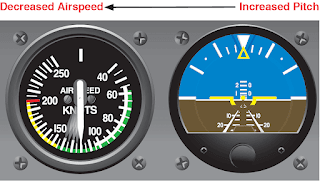 |
| Figure 15. Constant power plus increased pitch equals decreased airspeed |
Pitch control in level flight is a question of cross-check and interpretation of the instrument panel for the instrument information that enables a pilot to visualize and control pitch attitude. Regardless of individual differences in cross-check technique, all pilots should use the instruments that give the best information for controlling the airplane in any given maneuver. Pilots should also check the other instruments to aid in maintaining the primary instruments at the desired indication.
As noted previously, the primary instrument is the one that gives the most pertinent information for a particular maneuver. It is usually the one that should be held at a constant indication. Which instrument is primary for pitch control in level flight, for example? This question should be considered in the context of specific airplane, weather conditions, pilot experience, operational conditions, and other factors. Attitude changes must be detected and interpreted instantly for immediate control action in highperformance airplanes. On the other hand, a reasonably proficient instrument pilot in a slower airplane may rely more on the altimeter for primary pitch information, especially if it is determined that too much reliance on the attitude indicator fails to provide the necessary precise attitude information. Whether the pilot decides to regard the altimeter or the attitude indicator as primary depends on which approach will best help control the attitude. In this site, the altimeter is normally considered as the primary pitch instrument during level flight.
Bank Control
The bank attitude of an airplane is the angle between the airplane’s wings and the natural horizon. To maintain a straight-and-level flightpath, the wings of the airplane are kept level with the horizon (assuming the airplane is in coordinated flight). The instruments used for bank control are the attitude indicator, the heading indicator, and the turn coordinator. Figure 16 illustrates coordinated flight. The aircraft is banked left with the attitude indicator and turn coordinator indicating the bank. The heading indicator indicates a left turn by apparent clockwise rotation of the compass card behind the airplane silhouette.
 |
| Figure 16. Instruments used for bank control |
Attitude Indicator
The attitude indicator shows any change in bank attitude directly and instantly and is, therefore, a direct indicator. On the standard attitude indicator, the angle of bank is shown pictorially by the relationship of the miniature aircraft to the artificial horizon bar and by the alignment of the pointer with the banking scale at the top of the instrument. On the face of the standard three-inch instrument, small angles of bank can be difficult to detect by reference to the miniature aircraft, especially if leaning to one side or changing a seating position slightly. The position of the scale pointer is a good check against the apparent miniature aircraft position. Disregarding precession error, small deviations from straight coordinated flight can be readily detected on the scale pointer. The banking index may be graduated as shown in Figure 17, or it may be graduated in 30° increments.
 |
| Figure 17. Bank interpretation with the attitude indicator |
The instrument depicted in Figure 17 has a scale pointer that moves in the same direction of bank shown by the miniature aircraft. In this case, the aircraft is in a left 15° bank. Precession errors in this instrument are common and predictable, but the obvious advantage of the attitude indicator is an immediate indication of both pitch attitude and bank attitude in a single glance. Even with the precession errors associated with many attitude indicators, the quick attitude presentation requires less visual effort and time for positive control than other flight instruments.
Heading Indicator
The bank attitude of an aircraft in coordinated flight is shown indirectly on the heading indicator, since banking results in a turn and change in heading. Assuming the same airspeed in both instances, a rapid movement of the heading indicator (azimuth card in a directional gyro) indicates a large angle of bank, whereas slow movement reflects a small angle of bank. Note the rate of movement of the heading indicator and compare it to the attitude indicator’s degrees of bank. The attitude indicator’s precession error makes a precise check of heading information necessary in order to maintain straight flight.
When deviations from straight flight are noted on the heading indicator, correct to the desired heading using a bank angle no greater than the number of degrees to be turned. In any case, limit bank corrections to a bank angle no greater than that required for a standard rate turn. Use of larger bank angles requires a very high level of proficiency, and normally results in overcontrolling and erratic bank control.
Turn Coordinator
The miniature aircraft of the turn coordinator gives an indirect indication of the bank attitude of the airplane. When the miniature aircraft is level, the airplane is in straight flight. When the miniature airplane is aligned with one of the alignment marks and the aircraft is rolling to the left or right the indication represents the roll rate, with the alignment marks indicating a roll of 3 degrees per second in the direction of the miniature aircraft. This can be seen in level flight when a bank is introduced either to the left or the right. The turn coordinator’s indicator will indicate the rolling motion although there is no turn being made. Conversely, a pedal input to the right or left causes the aircraft to turn momentarily about its vertical axis (with no rolling motion) with an indication of turn on the turn coordinator. After the turn becomes stabilized and the aircraft is no longer rolling, the turn coordinator displays the rate of turn with the alignment marks equaling a turn of 3 degrees per second. The turn coordinator is able to display both roll and turn parameters because its electrically-powered gyroscope is canted at an angle. As a result, the turn-and-slip indicator provides both roll and turn indications. Autopilots in general aviation today use this instrument in determining both roll and turn information. After the completion of a turn, return to straight flight is accomplished by coordinated aileron and rudder pressure to level the miniature aircraft. Include the miniature aircraft in the cross-check and correct for even the smallest deviations from the desired position. When this instrument is used to maintain straight flight, control pressures must be applied very lightly and smoothly.
The ball of the turn coordinator is actually a separate instrument, conveniently located under the miniature aircraft because the two instruments are used together. The ball instrument indicates the quality of the turn. If the ball is off-center, the airplane is slipping or skidding. That is, if the coordinator’s miniature airplane is tilted left and the ball is displaced to the right, the aircraft is in a skid. [Figure 18] If however, the miniature airplane is tilted to the right with the ball off-center to the right, the aircraft is in a slip. [Figure 19] If the wings are level and the airplane is properly trimmed, the ball remains in the center, and the airplane is in straight flight. If the ball is not centered, the airplane is improperly trimmed.
 |
| Figure 18. Skid indication |
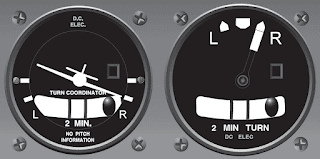 |
| Figure 19. Slip indication |
To maintain straight-and-level flight with proper trim, note the direction of ball displacement. If the ball is to the left of center and the left wing is low, apply left rudder pressure to center the ball and correct the slip. At the same time, apply right aileron pressure as necessary to level the wings, cross-checking the heading indicator and attitude indicator while centering the ball. If the wings are level and the ball is displaced from the center, the airplane is skidding. Note the direction of ball displacement and use the same corrective technique as for an indicated slip. Center the ball (left ball/left rudder, right ball/right rudder), use aileron as necessary for bank control and retrim.
To trim the airplane using only the turn coordinator, use aileron pressure to level the miniature aircraft and rudder pressure to center the ball. Hold these indications with control pressures, gradually releasing them while applying rudder trim sufficient to relieve all rudder pressure. Apply aileron trim, if available, to relieve aileron pressure. With a full instrument panel, maintain a wings-level attitude by reference to all available instruments while trimming the airplane.
Turn-and-Slip Indicator (Needle and Ball)
Unlike the turn coordinator that provides three indications (roll, turn, and trim), the turn-and-slip indicator provides two: turn-rate and trim. Although the turn-and-slip indicator needle provides an indication of turn only, it provides an indirect indication of aircraft attitude when used with roll indicators, such as a heading indicator or magnetic compass. As with the turn coordinator (after stabilizing from a roll), when the turn-and-slip indicator’s needle is aligned with the alignment marks, the aircraft is in a standard turn of 3 degrees per second or 360° in 2 minutes.
The ball of the turn-and-bank indicator provides important trim in the same manner that the ball in the turn coordinator does. Figures 18 and 19 provide a comparison of the two instruments.
Power Control
The relationship between altitude and airspeed determines the need for a change in pitch or power. If the airspeed is not the desired value, always check the altimeter before deciding that a power change is necessary. Think of altitude and airspeed as interchangeable; altitude can be traded for airspeed by lowering the nose or convert airspeed to altitude by raising the nose. If altitude is higher than desired and airspeed is low, or vice versa, a change in pitch alone may return the airplane to the desired altitude and airspeed. [Figure 20] If both airspeed and altitude are high or if both are low, then a change in both pitch and power is necessary in order to return to the desired airspeed and altitude. [Figure 21]
 |
| Figure 20. Airspeed low and altitude high—lower pitch |
 |
| Figure 21. Airspeed and altitude high—lower pitch and reduce power |
For changes in airspeed in straight-and-level flight, pitch, bank, and power must be coordinated in order to maintain constant altitude and heading. When power is changed to vary airspeed in straight-and-level flight, a single-engine, propeller-driven airplane tends to change attitude around all axes of movement. Therefore, to maintain constant altitude and heading, apply various control pressures in proportion to the change in power. When power is added to increase airspeed, the pitch instruments indicate a climb unless forward elevator control pressure is applied as the airspeed changes. With an increase in power, the airplane tends to yaw and roll to the left unless counteracting aileron and rudder pressures are applied. Keeping ahead of these changes requires increasing cross-check speed, which varies with the type of airplane and its torque characteristics, the extent of power, and speed change involved.
Power Settings
Power control and airspeed changes are much easier when approximate power settings necessary to maintain various airspeeds in straight-and-level flight are known in advance. However, to change airspeed by any appreciable amount, the common procedure is to underpower or overpower on initial power changes to accelerate the rate of airspeed change. (For small speed changes, or in airplanes that decelerate or accelerate rapidly, overpowering or underpowering is not necessary.)
Consider the example of an airplane that requires 23 inches of mercury (“Hg) of manifold pressure to maintain a normal cruising airspeed of 120 knots, and 18 “Hg of manifold pressure to maintain an airspeed of 100 knots. The reduction in airspeed from 120 knots to 100 knots while maintaining straight-and-level flight is discussed below and illustrated in Figures 22, 23, and 24.
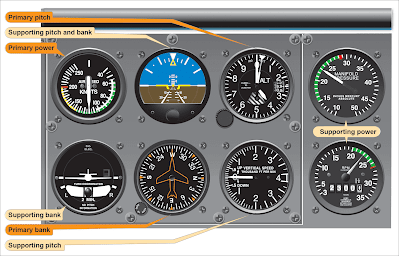 |
| Figure 22. Straight-and-level flight (normal cruising speed) |
 |
| Figure 23. Straight-and-level flight (airspeed decreasing) |
 |
| Figure 24. Straight-and-level flight (reduced airspeed stabilized) |
Instrument indications, prior to the power reduction, are shown in Figure 22. The basic attitude is established and maintained on the attitude indicator. The specific pitch, bank, and power control requirements are detected on these primary instruments:
- Altimeter—Primary Pitch
- Heading Indicator—Primary Bank
- Airspeed Indicator—Primary Power
Supporting pitch-and-bank instruments are shown in Figure 23. Note that the supporting power instrument is the manifold pressure gauge (or tachometer if the propeller is fixed pitch). However, when a smooth power reduction to approximately 15 “Hg (underpower) is made, the manifold pressure gauge becomes the primary power instrument. [Figure 23] With practice, power setting can be changed with only a brief glance at the power instrument, by sensing the movement of the throttle, the change in sound, and the changes in the feel of control pressures.
As thrust decreases, increase the speed of the cross-check and be ready to apply left rudder, back-elevator, and aileron control pressure the instant the pitch-and-bank instruments show a deviation from altitude and heading. As proficiency is obtained, a pilot learns to cross-check, interpret, and control the changes with no deviation of heading and altitude. Assuming smooth air and ideal control technique as airspeed decreases, a proportionate increase in airplane pitch attitude is required to maintain altitude. Similarly, effective torque control means counteracting yaw with rudder pressure.
As the power is reduced, the altimeter is primary for pitch, the heading indicator is primary for bank, and the manifold pressure gauge is momentarily primary for power (at 15 “Hg in this example). Control pressures should be trimmed off as the airplane decelerates. As the airspeed approaches the desired airspeed of 100 knots, the manifold pressure is adjusted to approximately 18 “Hg and becomes the supporting power instrument. The ASI again becomes primary for power. [Figure 24]
Airspeed Changes in Straight-and-Level Flight
Practice of airspeed changes in straight-and-level flight provides an excellent means of developing increased proficiency in all three basic instrument skills and brings out some common errors to be expected during training in straight-and-level flight. Having learned to control the airplane in a clean configuration (minimum drag conditions), increase proficiency in crosscheck and control by practicing speed changes while extending or retracting the flaps and landing gear. While practicing, be sure to comply with the airspeed limitations specified in the POH/AFM for gear and flap operation.
Sudden and exaggerated attitude changes may be necessary in order to maintain straight-and-level flight as the landing gear is extended and the flaps are lowered in some airplanes. The nose tends to pitch down with gear extension, and when flaps are lowered, lift increases momentarily (at partial flap settings) followed by a marked increase in drag as the flaps near maximum extension.
Control technique varies according to the lift and drag characteristics of each airplane. Accordingly, knowledge of the power settings and trim changes associated with different combinations of airspeed, gear, and flap configurations reduces instrument cross-check and interpretation problems.
For example, assume that in straight-and-level flight instruments indicate 120 knots with power at 23 “Hg/2,300 revolutions per minute (rpm), gear and flaps up. After reduction in airspeed, with gear and flaps fully extended, straight-and-level flight at the same altitude requires 25 “Hg manifold pressure/2,500 rpm. Maximum gear extension speed is 115 knots; maximum flap extension speed is 105 knots. Airspeed reduction to 95 knots, gear and flaps down, can be made in the following manner:
- Maintain rpm at 2,500, since a high power setting is used in full drag configuration.
- Reduce manifold pressure to 10 “Hg. As the airspeed decreases, increase cross-check speed.
- Make trim adjustments for an increased angle of attack and decrease in torque.
- Lower the gear at 115 knots. The nose may tend to pitch down and the rate of deceleration increases. Increase pitch attitude to maintain constant altitude, and trim off some of the back-elevator pressures. If full flaps are lowered at 105 knots, cross-check, interpretation, and control must be very rapid. A simpler technique is to stabilize attitude with gear down before lowering the flaps.
- Since 18 “Hg manifold pressure will hold level flight at 100 knots with the gear down, increase power smoothly to that setting until the ASI shows approximately 105 knots. The attitude indicator now shows approximately two-and-a-half bar width nosehigh in straight-and-level flight.
- Actuate the flap control and simultaneously increase power to the predetermined setting (25 “Hg) for the desired airspeed, and trim off the pressures necessary to hold constant altitude and heading. The attitude indicator now shows a bar width nose-low in straight-and-level flight at 95 knots.
Proficiency in straight-and-level flight is attained when a pilot can consistently maintain constant altitude and heading with smooth pitch, bank, power, and trim control during the pronounced changes in aircraft attitude.
Trim Technique
Proper trim technique is essential for smooth and precise aircraft control during all phases of flight. By relieving all control pressures, it is much easier to hold a given attitude constant and devote more attention to other flight deck duties.
An aircraft is trimmed by applying control pressures to establish a desired attitude, then adjusting the trim so the aircraft maintains that attitude when the flight controls are released. Trim the aircraft for coordinated flight by centering the ball of the turn-and-slip indicator, by using rudder trim in the direction the ball is displaced from the center. Differential power control on multiengine aircraft is an additional factor affecting coordinated flight. Use balanced power or thrust, when possible, to aid in maintaining coordinated flight.
Changes in attitude, power, or configuration requires a trim adjustment in most cases. Using trim alone to establish a change in aircraft attitude invariably leads to erratic aircraft control. Smooth and precise attitude changes are best attained by a combination of control pressures and trim adjustments. Therefore, when used correctly, trim adjustment is an aid to smooth aircraft control.
Common Errors in Straight-and-Level Flight
Pitch
Pitch errors usually result from the following faults:
- Improper adjustment of the attitude indicator’s miniature aircraft to the wings-level attitude. Following the initial level off from a climb, check the attitude indicator and make any necessary adjustment in the miniature aircraft for level flight indication at normal cruise airspeed.
- Insufficient cross-check and interpretation of pitch instruments. For example, the airspeed indication is low. The pilot, believing a nose-high attitude exists, applies forward pressure without noting that a low power setting is the cause of the airspeed discrepancy. Increase cross-check speed to include all relevant instrument indications before making a control input.
- Uncaging the attitude indicator (if caging feature is present) when the airplane is not in level flight. The altimeter and heading indicator must be stabilized with airspeed indication at normal cruise before pulling out the caging knob to obtain correct indications in straight-and-level flight at normal cruise airspeed.
- Failure to interpret the attitude indicator in terms of the existing airspeed.
- Late pitch corrections. Pilots commonly like to leave well enough alone. When the altimeter indicates a 20 foot error, there is a reluctance to correct it, perhaps because of fear of overcontrolling. If overcontrolling is the anticipated error, practice small corrections and find the cause of overcontrolling. If any deviation is tolerated, errors increase.
- Chasing the vertical speed indications. This tendency can be corrected by proper cross-check of other pitch instruments, as well as by increasing overall understanding of instrument characteristics.
- Using excessive pitch corrections for the altimeter evaluation. Rushing a pitch correction by making a large pitch change usually aggravates the existing error, saving neither time nor effort.
- Failure to maintain established pitch corrections, a common error associated with cross-check and trim errors. For example, having established a pitch change to correct an altitude error, there is a tendency to slow down the cross-check, waiting for the airplane to stabilize in the new pitch attitude. To maintain the attitude, continue to cross-check and trim off the pressures.
- Fixations during cross-check. After initiating a heading correction, for example, there is a tendency to become preoccupied with bank control and miss errors in pitch attitude. Likewise, during an airspeed change, unnecessary gazing at the power instrument is common. A small error in power setting is of less consequence than large altitude and heading errors. The airplane will not decelerate any faster by staring at the manifold pressure gauge.
Heading
Heading errors usually result from the following faults:
- Failure to cross-check the heading indicator, especially during changes in power or pitch attitude.
- Misinterpretation of changes in heading, with resulting corrections in the wrong direction.
- Failure to note and remember a preselected heading.
- Failure to observe the rate of heading change and its relation to bank attitude.
- Overcontrolling in response to heading changes, especially during changes in power settings.
- Anticipating heading changes with premature application of rudder control.
- Failure to correct small heading deviations. Unless zero error in heading is the goal, a pilot will tolerate larger and larger deviations. Correction of a 1 degree error takes a lot less time and concentration than correction of a 20° error.
- Correcting with improper bank attitude. If correcting a 10° heading error with 20° of bank, the airplane rolls past the desired heading before the bank is established, requiring another correction in the opposite direction. Do not multiply existing errors with errors in corrective technique.
- Failure to note the cause of a previous heading error and thus repeating the same error. For example, the airplane is out of trim, with a left wing low tendency. Repeated corrections for a slight left turn are made, yet trim is ignored.
- Failure to set the heading indicator properly or failure to uncage it.
Power
Power errors usually result from the following faults:
- Failure to know the power settings and pitch attitudes appropriate to various airspeeds and airplane configurations.
- Abrupt use of throttle.
- Failure to lead the airspeed when making power changes. For example, during airspeed reduction in level flight, especially with gear and flaps extended, adjust the throttle to maintain the slower speed before the airspeed actually reaches the desired speed. Otherwise, the airplane decelerates to a speed lower than that desired, resulting in additional power adjustments. The amount of lead depends upon how fast the airplane responds to power changes.
- Fixation on airspeed or manifold pressure instruments during airspeed changes, resulting in erratic control of both airspeed and power.
Trim
Trim errors usually result from the following faults:
- Improper adjustment of seat or rudder pedals for comfortable position of legs and feet. Tension in the ankles makes it difficult to relax rudder pressures.
- Confusion about the operation of trim devices that differ among various airplane types. Some trim wheels are aligned appropriately with the airplane’s axes; others are not. Some rotate in a direction contrary to what is expected.
- Faulty sequence in trim technique. Trim should be used not as a substitute for control with the wheel (stick) and rudders, but to relieve pressures already held to stabilize attitude. As proficiency is gained, little conscious effort is required to trim off the pressures as they occur.
- Excessive trim control. This induces control pressures that must be held until the airplane is trimmed properly. Use trim frequently and in small amounts.
- Failure to understand the cause of trim changes. Lack of understanding the basic aerodynamics related to basic instrument skills causes a pilot to continually lag behind the airplane.
